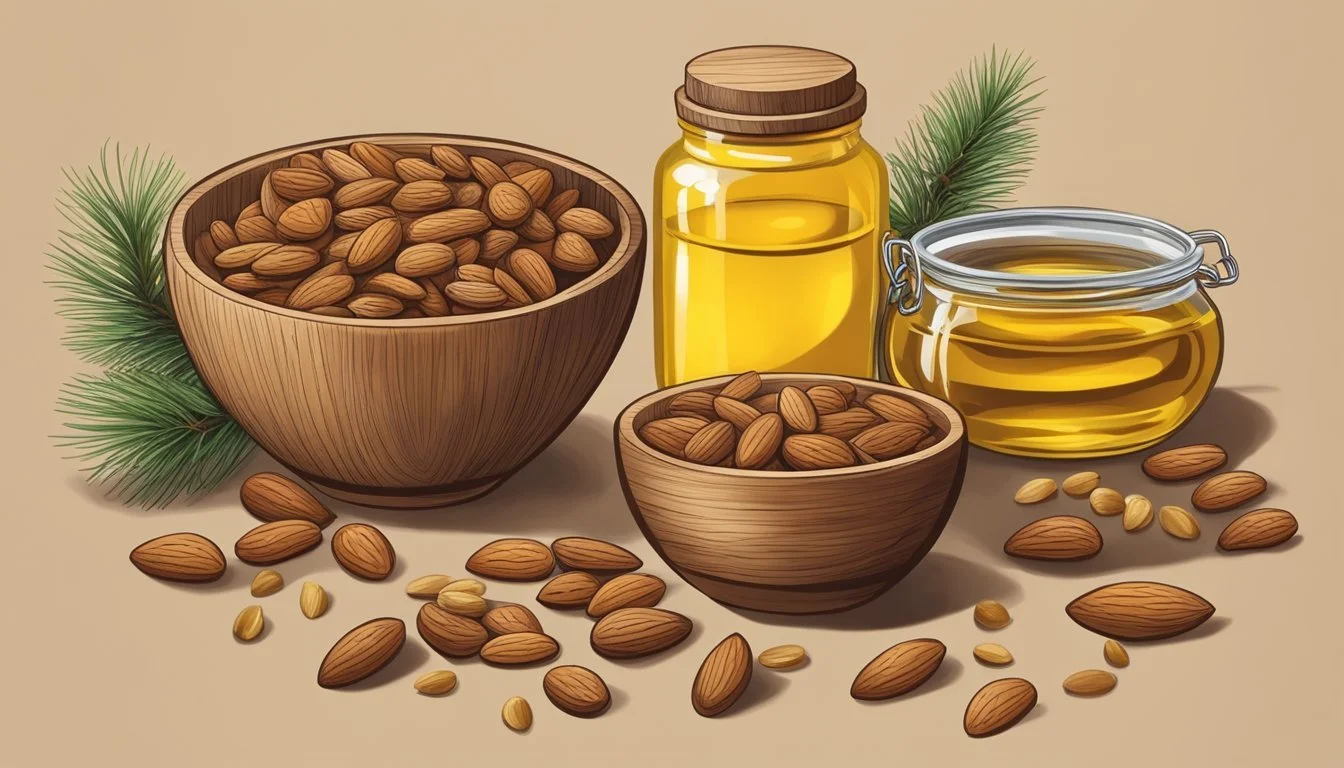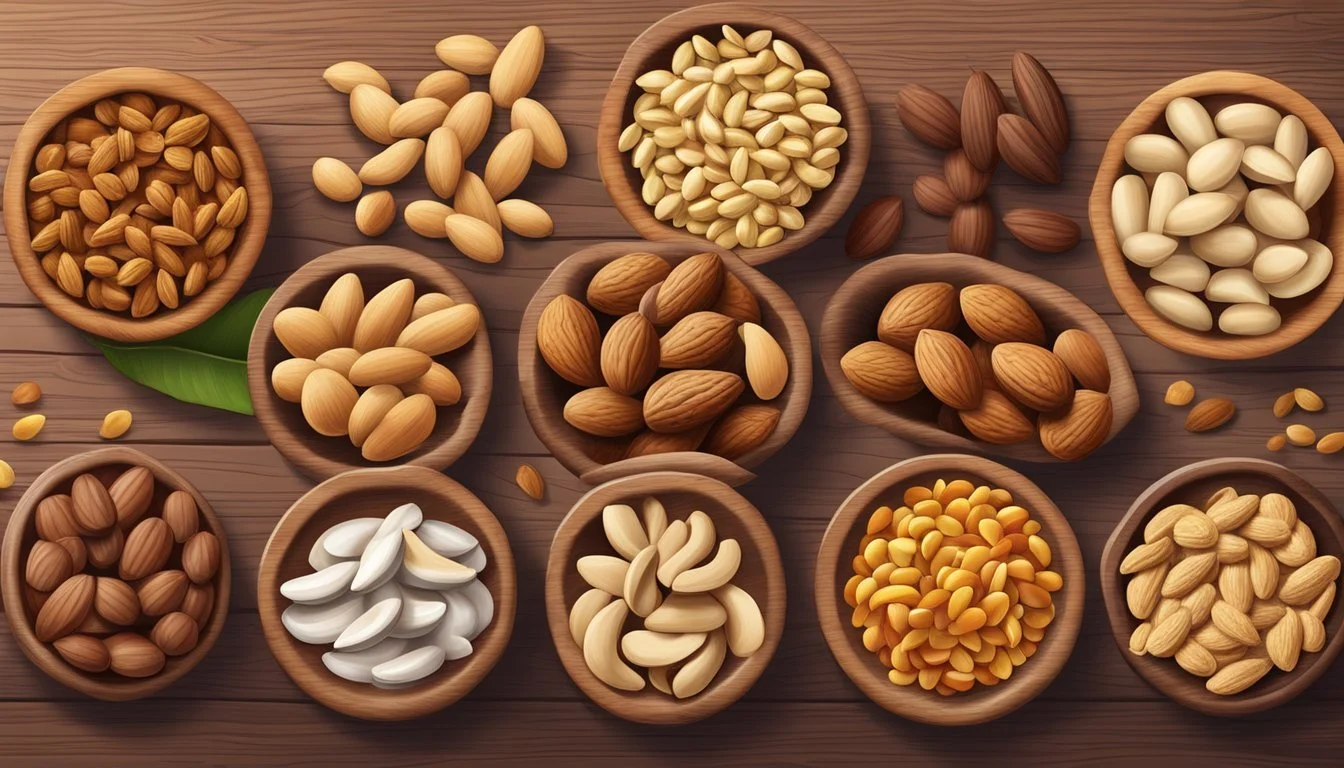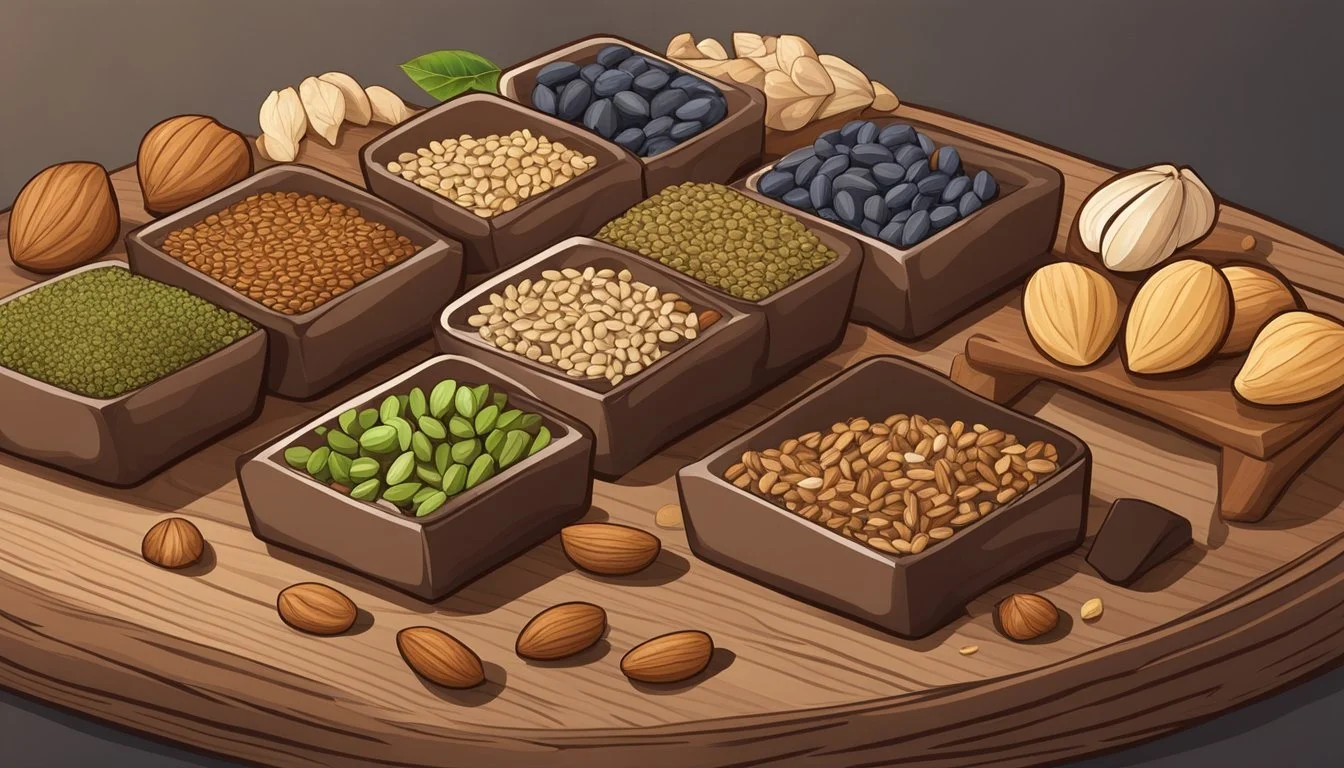Pine Nut Substitutes
Top Alternatives for Your Recipes
Pine nuts, with their rich and buttery flavor, are a prized ingredient in many dishes ranging from classic pesto to salads and baked goods. However, their high cost and potential allergenic properties prompt many cooks to seek out suitable substitutes. A variety of alternatives exists that can mimic or complement the distinct taste and texture of pine nuts, ensuring that dishes retain their intended deliciousness without compromising on quality.
Identifying an apt substitute for pine nuts depends on the specific culinary application. For sweet and savory recipes, options such as hazelnuts and cashews provide a comparable nutty taste and creamy texture. Pecans and pistachios also offer subtle sweetness and can seamlessly blend into dishes traditionally calling for pine nuts. On the more affordable end, peanuts serve as an economical alternative, extending the range of ingredient choices available to the home cook.
When substituting for pine nuts, understanding the flavor profile and texture of the alternatives helps in making a seamless swap. The diverse selection of substitutes caters to various dietary preferences and budgetary considerations, making the versatility of culinary creations as accessible as they are flavorful.
Understanding Pine Nuts and Their Role in Recipes
Pine nuts play a pivotal role in various cuisines, offering a unique flavor and texture to a range of recipes. These small yet mighty seeds are cherished for their contribution to both taste and nutrition.
Culinary Uses of Pine Nuts
Pine nuts are commonly used in pesto, where their buttery quality blends seamlessly with basil, Parmesan, and olive oil. Their subtle taste is a key component in elevating the flavors in pasta dishes and salads. In baking, they contribute to the texture and richness of desserts, such as cakes and cookies, while also adding a distinct, nutty crunch.
Flavor and Texture Profiles
The flavor of pine nuts is often described as nutty and buttery, with an underlying richness that is both creamy and oily. The texture is smooth and almost buttery, which is why they meld so well into pasta and spreadable sauces. This unique flavor and texture make pine nuts a coveted ingredient in many areas of cuisine.
Nutritional Benefits
Pine nuts are not only appreciated for taste but are also known for their health benefits. They are a good source of protein and contain magnesium, vitamin E, healthy fats, and antioxidants, which can help maintain healthy cholesterol levels. The nuts' nutritional profile includes a range of minerals and vitamins that contribute to overall health.
Protein: Essential for muscle growth and repair
Magnesium: Supports nerve function and bone health
Fats: Primarily monounsaturated, contributing to heart health
Vitamin E: An antioxidant important for skin and immune health
Antioxidants: Help combat oxidative stress in the body
Common Pine Nut Substitutes
Identifying a suitable pine nut substitute is essential for those looking to replicate the nut’s unique flavor and texture in various recipes. Given below are non-nut and nut-based alternatives, each offering distinct taste profiles and textural qualities to cater to diverse culinary needs.
Nuts and Seeds Alternatives
When looking for alternatives within the realm of nuts and seeds, there are several options that can mimic the characteristic qualities of pine nuts:
Cashews: They share a similar mild sweetness and are best used in a roughly 3:2 ratio to pine nuts. Their soft consistency makes them perfect for blending into sauces like pesto.
Almonds: With their slightly sweet and earthy taste, almonds can be a good substitute, especially when slivered or chopped.
Walnuts: Offering a meaty texture, walnuts add a robust profile to dishes that require pine nuts.
Hazelnuts: Their earthy, nutty flavor pairs well with both sweet and savory recipes, providing an excellent texture akin to pine nuts.
Pecans: Similar to pine nuts with a bit of sweetness, pecans can be used in salads and baking.
Pistachios: Their vibrant color and distinct flavor can be a pleasant alternative in many recipes, though they are more aromatic.
Macadamia Nuts: A creamier and richer textured nut, useful in desserts and sauces.
Brazil Nuts: Larger in size with a meatier texture, they should be chopped or sliced for best incorporation into dishes.
Among seeds that can substitute for pine nuts, one may consider:
Sunflower Seeds: An inexpensive option with a nutty flavor; suitable for those with nut allergies.
Pumpkin Seeds: Also known as pepitas, they offer a crunch and a subtly sweet, nutty flavor.
Sesame Seeds: Although smaller, they can be toasted to bring out a nutty essence.
Hemp Seeds: These seeds deliver a nutty taste and soft texture much like pine nuts.
Non-Nut Alternatives
For those avoiding nuts, either due to allergies or dietary preferences, the following can provide a similar satisfaction:
Edamame: These young soybeans have a softer consistency but can replicate the bulk that pine nuts offer in a dish.
White Beans: Mild in flavor with a creamy texture, they can be pureed and used in recipes requiring a more subdued nut replacement.
Peanuts: Although technically legumes, their ubiquity and nutty characteristics make them a convenient and cost-effective swap, suitable for a variety of dishes.
How to Choose a Substitute
When selecting a substitute for pine nuts, one must consider any allergy or dietary constraints and find an alternative that closely matches the desired texture and flavor profile of pine nuts.
Considering Allergy and Dietary Restrictions
For individuals with nut allergies, it's imperative to select nut-free alternatives like sunflower seeds or pumpkin seeds that are nutritious and maintain a similar texture but without the allergens. For those on special diets, seeds can also be a healthy alternative, as they contain beneficial fats and are less processed. It's crucial to ensure that the substitute respects the dietary restrictions and health considerations of your audience.
Matching Texture and Flavor Profiles
To capture the classic nutty flavor and buttery texture of pine nuts, alternatives like cashews or blanched almonds can be ideal due to their similar characteristics:
Cashews:
Creamy texture
Mild, sweet nutty flavor
Use in a 3:2 ratio compared to pine nuts
Blanched Almonds:
Smooth, less earthy but have a comparable size to pine nuts
Provide a gentle nutty note when used in recipes
For a more earthy tone, hazelnuts or walnuts are suitable substitutes. They offer a robust flavor, which though not identical, can complement dishes where pine nuts are traditionally used:
Walnuts:
Stronger, slightly bitter flavor
Excellent crunch
Hazelnuts:
Distinct earthy undertone
Ideal for both sweet and savory dishes
The key is to find a substitute that harmonizes with the other flavors in the dish while adding a similar texture, be it creamy, buttery or retaining a pleasant crunch similar to pine nuts.
Preparing Substitutes for Pine Nuts
When preparing substitutes for pine nuts, it's crucial to replicate the desired texture and flavor characteristics, such as richness and mild earthiness. Appropriate preparation techniques can enhance these qualities, significantly affecting the success of the substitute in recipes.
Toasting and Roasting Techniques
Toasting or roasting nuts and seeds deepens their flavor, accentuating their natural sweetness and yielding a more robust taste profile. Here's a concise guide:
Cashews: To achieve a toasted flavor, spread raw cashews evenly on a baking sheet. Roast in a preheated 350°F (175°C) oven for 8-10 minutes, until golden and fragrant.
Sunflower Seeds: For a toasted, nutty flavor similar to pine nuts, spread sunflower seeds on a baking sheet and roast at 350°F (175°C) for about 5 minutes until slightly browned.
Transfer toasted nuts and seeds to a plate immediately after roasting to prevent them from becoming bitter due to residual heat.
Soaking and Peeling Methods
Soaking and peeling nuts can enhance their smoothness, closely mimicking the delicate texture of pine nuts.
Almonds (if used as a substitute): Soak the almonds in warm water for 6-8 hours. The skins loosen, making them easy to peel, which removes bitterness and results in a creamier consistency.
Be sure to pat the nuts or seeds dry after soaking to avoid spattering during roasting or toasting. Additionally, peeled nuts have a milder flavor and a more inviting texture, especially useful in preparations like pesto, where pine nuts are traditionally a primary ingredient.
Using Substitutes in Specific Dishes
When cooking with pine nut substitutes, it is crucial to select the right alternative to maintain the desired flavors and textures of specific dishes. Substitutes should complement the ingredients of the dish, whether it's for the creamy characteristic in sauces like pesto, the crunch in salads, or the meaty texture in main courses.
Pesto and Other Sauces
For pesto and other creamy sauces where pine nuts impart a mild, nutty flavor and contribute to the rich, green color, cashews are an exceptional alternative. They provide a similar texture and sweetness. One can toast cashews slightly to enhance their flavor before blending with parsley or basil, cheese, and olive oil.
Substitution Example for Pesto:
Cashews: Use in a ratio of 3:2 (e.g., 1.5 tablespoons cashews for 1 tablespoon pine nuts).
Salads and Baked Goods
Salads often benefit from the addition of nuts for extra crunch and flavor, and baked goods such as cookies, cakes, or stuffings call for a delicate texture and nutty taste.
Hazelnuts: Best used in desserts for their earthy flavor.
Pecans: Offer a slightly sweet note and a creamy consistency. They should be toasted to mimic the robust flavor of pine nuts.
Substitution Tips:
Salads: Sprinkle chopped hazelnuts or pecans on top.
Cookies & Cakes: Replace pine nuts with equal parts hazelnuts or pecans.
Main Courses and Stir-Fries
Pine nuts can be expensive, however, one can use more budget-friendly nuts without compromising the dish's integrity. Good substitutes should be affordable and still provide a similar meaty texture.
Peanuts: An inexpensive option for a meaty texture in stir-fries.
Main Course Alternatives:
Budget-friendly: Substitute with peanuts in equal proportions to pine nuts.
When integrating a pine nut alternative into pasta dishes or other main recipes, consider the overall flavor profile and make sure the chosen substitute will complement the other ingredients used.
Economical Considerations for Pine Nut Substitutes
Pine nuts are often considered a luxury ingredient due to their price tag, leading many to seek out more budget-friendly alternatives that still offer similar flavor and texture to dishes.
Comparing Price Points
The cost of pine nuts can be higher than many other nut varieties, making it important to analyze price points when looking for alternatives. Substitutes such as peanuts tend to be at the lower end of the spectrum, being one of the most inexpensive options. Here's a brief comparison based on average retail prices:
These prices can fluctuate depending on the region, brand, and whether the nuts are organic or non-organic. Peanuts offer substantial savings, while pecans sit closer to pine nuts in terms of cost, but can still be less expensive.
Balancing Quality and Cost
The search for an economical substitute for pine nuts also involves a balance between cost and quality to maintain the desired outcome in dishes. Hazelnuts and cashews are examples of substitutes that can provide a similar nutty flavor and creamy texture without breaking the bank.
Hazelnuts: Offer an earthy, rich flavor suitable for both savory and sweet dishes, making them an excellent middle-ground choice for those looking to manage cost without compromising on taste.
Cashews: Similar in color and texture to pine nuts, they are adaptable to many recipes and can be toasted to enhance their flavor, providing a blend of affordability and quality.
Choosing an alternative nut based on both price and quality requires consideration of how the substitute will interact with other ingredients in terms of flavor and texture, ensuring an economical yet still delicious result.
Health Aspects of Alternatives to Pine Nuts
When considering alternatives to pine nuts, one must scrutinize their health benefits, including protein content, vitamin levels, and the presence of antioxidants. Additionally, the suitability of these alternatives for those with nut allergies and specific dietary requirements is crucial.
Dietary Benefits and Considerations
Protein Content: Many pine nut substitutes, such as almonds and sunflower seeds, provide a good source of protein which is essential for muscle repair and growth. For instance, almonds contain approximately 6 grams of protein per ounce.
Fat Content: Substitutes like cashews and walnuts contain healthy fats that are beneficial for heart health but should be consumed in moderation due to their high caloric density.
Nutrition Profile: Alternatives such as sunflower seeds are rich in magnesium, which supports nerve function and immunity, and vitamin E, an important antioxidant that protects cells from damage.
Allergen Considerations: For those with nut allergies, seeds like pumpkin and sunflower seeds present a safe alternative, allowing individuals to enjoy similar textures and flavors without the allergenic components.
Addressing Specific Health Goals
Cholesterol Management: Pecans and walnuts can aid in lowering cholesterol levels due to their high levels of monounsaturated fats.
Immune Support: Seeds and nuts typically contain antioxidants that support immune health. For example, almonds are high in vitamin E, which has been linked to enhanced immunity.
Unique Flavor and Health Benefits: Each substitute brings not only a unique flavor to dishes but also specific health benefits. Hazelnuts, rich in antioxidants, may contribute to skin health and reduction of inflammation.
Nut Allergies and Alternatives: For individuals avoiding nuts due to allergies, seed-based substitutes offer nutritional benefits without compromising health. Sunflower seeds, for example, provide a nut-free option that's also abundant in nutrients.






